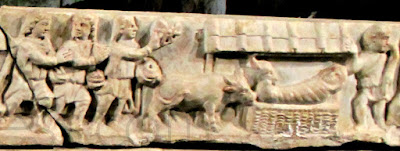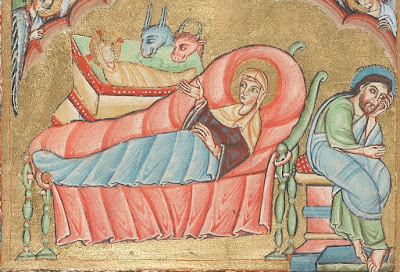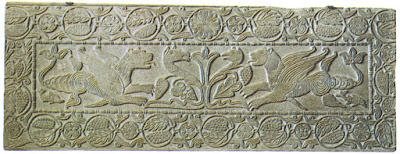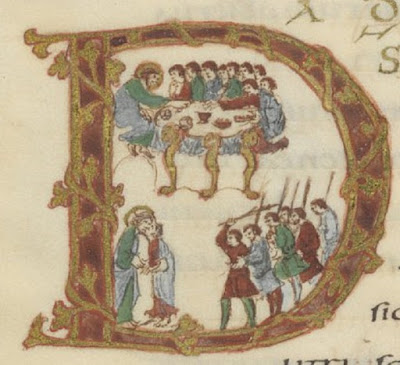 |
| A Carolingian Era Nativity scene from the British Museum |
Art historians will often try to show evolutions and trends of certain themes or topics in art, and how they originated and shifted over time. When it comes to early art, this is not easy, and is sometimes impossible, because so few examples are left. We can take one image and compare it to another and see the differences, but since there would have originally been hundreds, if not thousands of examples, it is impossible to deduct any meaningful or conclusive trend from the differences seen in the few surviving examples. All we can safely conclude, is that the subject being depicted is the same, and the imagery is different.
Having said that, however, change did occur, and the nativity scene, as we see it in front of churches today, is very different than it was in the early Middle Ages. As time marched on, some elements were dropped, others added, and still others took on different forms. Somehow, however, the basic core has remained constant, and we are easily able to recognise the earliest scenes for what they are even if many aspects of the iconography have changed,
The Christmas story is at the very beginning of our modern era, so much so, that that event is the basis for the dates that we use today. As I am writing this, it is 24 December, 2017; that 2017 represents that many years since the very first Christmas, even if it was no actually celebrated as such in the year 1. Somehow, between that year and the 4th century, Christianity had taken hold as a major religion, and the artwork and iconography associated with it had come into full bloom, although the period we know as "medieval" was still another 200 years in the future. There are many representations of the Nativity on 4th and 5th century stone sarcophagi, which come from the regions under the influence of the Roman Empire. I have pictured a few of them here so that the similarities and differences with early medieval artwork can be seen.
 |
| Part of an ivory panel in the British Museum, depicting a 6th century version of the Nativity (the 6th century marks the beginning of the medieval period.) |
 |
| Panel on the back of the "Throne of Maximian" in Ravena, 6th century |
Not much had changed (at least as far as these examples are concerned) by the 6th century and the "dawn of the Middle Ages". No one had told the people of the 6th century that they were entering the "dark Ages" so they kept right on doing what they had been doing before the so-called "Fall of the Roman Empire". (meaning there is no distinction between "Byzantine" and "Roman" before the Middle Ages; Byzantium and Rome were one and the same) People who had been under the influence of Rome kept on being "Roman" and doing as they had done, and the Germanic tribes kept on with their "Celtic" roots and continued doing what they had done. A gradual fusion of those two styles eventually gave us the "Romanesque" style of the 11th through 13th centuries, but the clash of the two traditions gave us "Early Medieval" art, which incorporated distinct elements of both. There is much more of the Roman influence in most of the surviving early medieval artwork depicting the Nativity.
The one change that can be seen, in these 6th century examples, lacking in the others, is the inclusion of Mary lying on some sort of stuffed matres type bed. Doubtless this is not the first example which depicts this element of the scene, and it is impossible to say when it might have first appeared. - Even if we have an object depicting a particular element or event, and it is positively dated earlier than any other artifact portraying the same event, the only conclusion we can positively draw is that it is the oldest one we know of, not that that was the first time that event or idea had been represented.
I am not completely certain if the above pictured object is actually from the 7th century, I found it on the internet, and supposedly it comes from the monastery of St Catherine in Sinai, Egypt, but I was unable to verify that. It does look very similar to other artwork from that area and era, so until dis-proven, I will go along with the notion that it is. Here we can see elements of Egyptian art creeping into the Greco-Roman style, but it is still basically the same forms, just represented in a different medium, and with a colloquium influence to it.
In this painting, we have the Three Magi, but they have been around since at least the third century, though not always portrayed as "kings", as can be seen in another Roman sarcophagus, pictured below. Another element that is new, at least to the images we have looked at, is the "manger", here portrayed as a piece of carved furniture. Another element added here is the announcing angels; these guys became very prominent by the 9th century, after which one hardly sees a nativity scene without them, though in most of the early examples we have seen, they are nowhere to be found.
 |
| The Three Magi make an appearance in this sarcophagus |
In fact, the one element which is constant throughout the entire narrative, but which, interestingly, has no biblical reference, is the "ox and the ass". These two characters are so wrapped into the tradition that were we to see a scene without them, we would doubtless not recognise it as being the Nativity. None of the gospel writers, however, mention anything about them, they are only a logical conclusion from the fact that he was, according to the stories, born in a manger, in a stable. (There is also an ambiguous passage in the book of Isaiah, sized upon by early theologians, referring to an ox and an ass, which was linked by them as being a prophetic reference to the birth of Christ)
Moving on to the 9th century, as we saw in the first image of this post, not much has changed yet. There are some slight stylistic changes that art historians can pick up on, which identify it as being 9th century, not 4th, 5th, or 6th, but essentially the scene remains unchanged. In this version, the manger is back to being made of stone, not a carved piece of furniture, but that is a decision of the artist, either as he wanted it, or as the model that he worked from had it portrayed; there are numerous variations in the portrayal of the manger and its style and composition by this time.
 |
| A 10th century ivory panel from Trier, still very much following the now 700+ year old Roman models; things changed much more slowly in the Middle Ages than they do now. |
Though this example looks very much like it could be from the previous century, that is perhaps a deliberate choice; much as people are still ornamenting things in the styles of bygone eras. The imagery had not changed very much, but the style of art had been shifting a bit more than one would guess from this picture. The trend for copying earlier decorative tastes goes back at least to the early Roman era, continued through the Middle Ages, and has never really gone away.
the first real shift that I can find from Roman era depictions, to those of the Middle Ages, is the shift from the depiction of Mary lying on a matres to one of her lying on a wooden framed bed. The picture below is an example of this, but interestingly, shows an hybrid Greco-Roman era/ western style bed, as opposed to a purely Western European type. (the canted upright supports at the head of the bed) This tells me that there might be, or had been, earlier depictions of the Nativity with Mary on such a bed, and even this idea is not new to the Middle Ages. However, from this point on, one finds many more examples of Mary lying in a bed made with legs and sides, yet still into the 13th century we also see examples of the formless matres type bed repeated. (which is, incidentally, shown on top of this bed frame)
 |
| A late Ottonian depiction of the Nativity, from a manuscript in the Getty Library. (1025-50 AD) |
One can see the shift that this scene has taken from the original Roman period models, but to this point most of that shift has been purely in the style of art. Only later, toward the end of the medieval period do we find nativity scenes which begin to resemble those we are accustomed to seeing now. At the core of it all, though, one thing that has never gone away is the lowly Ox and Ass, the central un-credited characters of this story.
Thus concludes the second year of this blog. Thanks to all the readers and fans who have helped keep it going.
Videre Scire

































